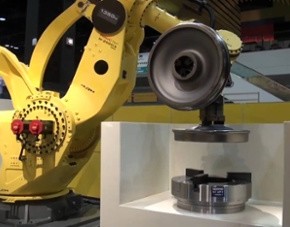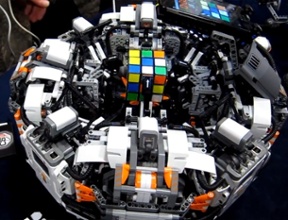
Robohub.org
15 official world records set by robots

image: Bill Wesner/flickr
Robots have been getting their names in the record books. Whether it’s taking the first pictures on the moon or observing the deepest volcanic eruption, robots are setting Guinness World Records alongside the most impressive humans. We take a look at 15 official world records which have been set, and beaten, by robots.
History was made recently, on the 27th of October, when a robot walked the equivalent of more than 3 ultramarathons in 54 hours, completely untethered and without recharging. Robot Xingzhe 1 (Walker 1) walked continuously for 134.04 km using only 0.8 kWh of power, totally smashing the previous record of 65 km set by Cornell University’s Ranger robot in 2011.
Though world records can often raise a laugh – particularly when you consider records such as: “fastest marathon dressed as a toilet (male)” and “longest eyelash on a dog” – they are an entertaining way of demonstrating a very serious point. They show us the very limits of our current abilities as a human race and the limits of the modern world.
Although Xingzhe 1’s walk seems to be an unofficial record (i.e. not adjudicated by the Guinness World Records), it demonstrates just how energy efficient we can make robots if we really try.
So, on this monumental occasion, what better excuse do we need to take a look back at some of the ‘official’ world records that have been set by robots?
Robots: A Whole New Category of World Record
World Records are set all the time, with more robots getting involved each year, although they’re not always the ones setting the records. This September a flailing robot hit a Guinness World Record adjudicator on the head as she judged the World’s Largest Meccano Structure – a temporary bridge built in Belfast, Ireland.
Most of the records listed are specifically set for robots. For Guinness World Records, it would seem, humans and robots are just separate categories of record makers.
Some robot records are “firsts” such as First Robot Trumpeter and First Robot Olympics. They mark a change in our modern world but can never again be broken. Other records will be broken again and again as our technology improves (meaning that some of this post is bound to go out of date).
Guinness World Records That Were Set by Robots
Strongest Robot Arm
 The Fanuc M-2000iA/1200 is a pretty massive robot with an impressive payload of 1,200kg. In October 2008, it beat the previous record of 1000kg, which had been held by the KUKA Titan for the previous 16 months.
The Fanuc M-2000iA/1200 is a pretty massive robot with an impressive payload of 1,200kg. In October 2008, it beat the previous record of 1000kg, which had been held by the KUKA Titan for the previous 16 months.
No doubt the record will be broken at some point in the future. However, the fact that seven years have passed since it was last broken suggests that industrial robot manufacturers have other priorities than breaking world records and making bigger robots. With both KUKA and Fanuc now moving into smaller collaborative robotics, perhaps this record will stand a bit longer.
Longest Journey by an Unmanned Autonomous Surface Vehicle
Although Xingzhe 1’s 134 km walk is impressive, it’s nothing when you compare it to the 14,703 km which were covered by the Wave Glider robot (nicknamed Benjamin Franklin) in February 2013. This impressive water vehicle used wave power to generate propulsion and solar panels to power its sensors. Setting off from San Francisco in November 2011, the craft arrived in Queensland, Australia in February 2013 after having crossed the Pacific Ocean.
First Pictures from the Moon
Back in July 1969, Neil Armstrong made “one small step for man” by becoming the first human to stand on the surface of the moon. We all know this. However, it’s less known that 3 years before, in February 1966, a robot broke another world record by sending back the first photos from the moon. The Luna 9 was sent up by the Soviet Union and transmitted photos back to earth for a total of four days.
Robot records will probably continue to be set in space due to the hostile environment. In May 2008, the First Successful Mars Polar Lander first set down its wheels onto the surface of the red planet.
Double Record: First Companion Robot in Space and Highest Altitude for a Robot to Have a Conversation
Speaking of robots in space, last March a Japanese humanoid called Kirobo set two Guinness World Records simultaneously as it boarded the International Space Station to join another robot record breaker, the Canadarm 2 – the Largest Robotic Arm in Space.
Designed in collaboration with the University of Tokyo, Kirobo is part of a project which aims to see if robots can become good companions for people in space. Could we be one step closer towards a real HAL 9000?
Along with other Guinness World Records like First Robot Babysitter and First Restaurant with Robot Waiting Staff, Kirobo’s world records could mark a change towards our acceptance of social robots as a real possibility for the future.
Deepest Observed Volcanic Eruption
One of the few robots that have set a non-robot-specific world record was a submersible robot named Jason. In December 2009, US scientists used Jason to video the West Mata Volcano erupting at more than 1.2 km below the Pacific Ocean near Samoa. It was the very first time that scientists had seen molten lava flowing on the sea floor.
First Human to be Killed by a Robot
Safety is a key concern with industrial robots and fatal accidents do happen though they are few and far between. Often accidents can be traced back to human error. The first human to be killed by a robot was Robert Williams, who worked in a Ford Motor Company factory and died in January 1979 when accessing a storage compartment shared with a robotic arm.
Since then, robots have moved from the factories and onto the battlefield. The record for First Use of Military Robots in Combat went to the Hermes robot which was used in 2002 in Afghanistan.
Fastest Robot to Solve a Rubik’s Cube
 Although other robot record-breakers beyond those on this list do exist, it makes sense to finish on the Rubik’s Cube solving robots.
Although other robot record-breakers beyond those on this list do exist, it makes sense to finish on the Rubik’s Cube solving robots.
Guinness World Records for solving various types of Rubik’s Cube are much fought for by both robot makers and human solvers alike. As a result, this particular record is likely to change rather quickly.
The human Rubik’s Cube record was set in April this year by Collin Burns, who can be seen in this video solving the cube in just 5.25 seconds.
The robotic record is currently held by the ARM-powered Lego robot called Cubestormer 3 which completed the cube in just 3.253 seconds in March 2014.
Who knows which World Records will be set by robots in the near future, but we can be sure that there is still room for a lot of robotic “firsts.”
f you liked this article, you may also be interested in:
- The robots in Ex Machina: VFX Q&A with Andrew Whitehurst
- A glimpse at our robotic future: 235 start-ups reviewed
- 12 favorite robot movies – new and old
- The real soft robots that inspired Baymax, with Chris Atkeson
See all the latest robotics news on Robohub, or sign up for our weekly newsletter.
tags: c-Events






